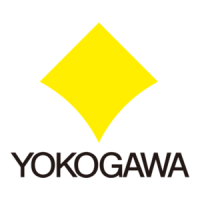
Do you have a question about the YOKOGAWA MX100 and is the answer not in the manual?
| Brand | YOKOGAWA |
|---|---|
| Model | MX100 |
| Category | Data Loggers |
| Language | English |
Important operational notes and conditions for configuring the MX100 system.
Lists registered trademarks associated with the product and software.
Details the publication history and edition dates of the manual.
Guidance on how to use this manual and product safety information.
Safety symbols and critical precautions for handling the instrument safely.
YOKOGAWA's warranty limitations and liability disclaimers.
Guidelines for using the accompanying software, including licensing and copying restrictions.
How to verify the model and suffix code on the instrument's nameplate.
List of standard accessories supplied with the main module.
Defines units like k, K, M, G used for data sizes and values.
Explains symbols like Danger, Warning, Caution, and Note used in the manual.
Describes the MX100's components: main module, input/output modules, and base plate.
Details the functions of the main module, including communications, measurement, and data storage.
Details the capabilities of the 4-channel high-speed universal input module.
Details the capabilities of the 10-channel medium-speed universal input module.
Details the capabilities of the 6-channel medium-speed 4-wire RTD input module.
Details the capabilities of the 4-channel medium-speed strain input module.
Details the capabilities of the 10-channel high-speed digital input module.
Details the capabilities of the 8-channel medium-speed analog output module.
Details the capabilities of the 8-channel medium-speed PWM output module.
Explains the operation of analog and PWM output modules under various conditions.
Details the capabilities of the 10-channel medium-speed digital output module.
General precautions for safely handling the MX100 instrument.
Guidance on selecting an installation location and the installation procedure.
Step-by-step instructions for attaching input/output modules to the base plate.
Detailed instructions for connecting various signal wires to the modules.
Procedure for connecting power and turning the MX100 ON/OFF.
Steps for establishing network connectivity using an Ethernet cable.
Methods and features used to minimize noise interference in measurement circuits.
Instructions and precautions for inserting, ejecting, and managing the CF card.
Lists error codes displayed on the 7-segment LED and their corrective actions.
Common problems and solutions for the MX100, including LED status and connectivity issues.
Procedures for calibrating the MX100's measurement ranges and temperature inputs.
Information on expendable parts like lithium batteries and their service life.
How to perform maintenance and tests using communication commands via Telnet.
General specifications covering operating conditions, mechanical details, and supported standards.
Detailed specifications for the MX100 main module, including measurement, computation, and data storage.
Specifications related to the base plate, including dimensions and module capacity.
Detailed specifications for the 4-channel high-speed universal input module.
Detailed specifications for the 10-channel medium-speed universal input module.
Detailed specifications for the 6-channel medium-speed 4-wire RTD input module.
Detailed specifications for the 4-channel medium-speed strain input module.
Detailed specifications for the 10-channel high-speed digital input module.
Detailed specifications for the 8-channel medium-speed analog output module.
Detailed specifications for the 8-channel medium-speed PWM output module.
Common operations and specifications for analog and PWM output modules.
Detailed specifications for the 10-channel medium-speed digital output module.
Introduces the functions of the /DS option, including mode retention and dual save.
Configuration settings for the dip switches to enable /DS option functions.
Detailed explanation of operation modes and functions related to the /DS option.
Describes the naming convention and structure of data files created on the CF card.